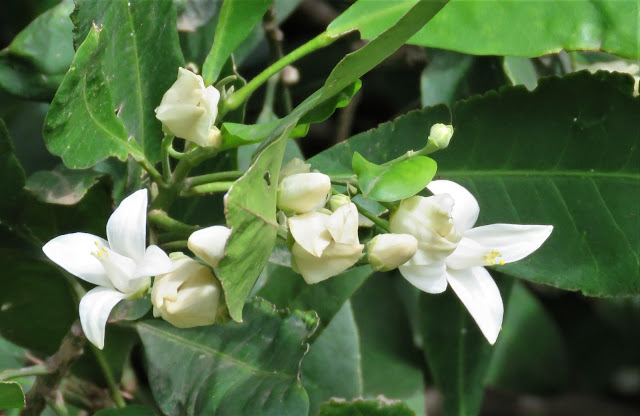Pinkheart wins over botanic garden directors
The flowers were mostly spent when I walked past, in late April. I peeled open one to release a rather intense citrus perfume. Almost too intense. Let's say pungent, if you can imagine that being applied to an orange or lemon odor. The leaves have a similarly strong hit of citrus.
The shape of the flowers and that perfumery suggested something in the plant family Rutaceae. That's where lemons and oranges sit, along with boronias and other aromatic shrubs and trees.
It didn't take too much digging to identify it as Medicosma cunninghammii, an Australian rainforest trees sometimes called Pinkheart or Bonewood. Take your pick, the poetic or pragmatic.
Wikipedia describes the Pinkheart (I'll go poetic) as a 'small crooked tree'. Not unreasonable in this case. The habit of this tree at the northern end of Fern Gully, in Melbourne Gardens, is a bit scrappy.
In nature it lives in subtropical and near coastal rainforests, north of Richmond River and up into south-eastern Queensland. So near the creek in Fern Gully, which includes quite a few subtropical plants, is a good fit.
It has leaves in pairs, opposite one-another, a good diagnostic feature for this genus. As are the four-petaled flowers with twice as many stamens (the male bits, forming a cone in the fresh flowers), and the scale-like or star-shaped hairs on many parts of the plant (but not visible in my pictures).
English plant collector and briefly Superintendent (Director) of Sydney's Botanic Gardens, Alan Cunningham, first collected (for science) Pinkheart from near Moreton Bay in Queensland, in 1829. It was sent to Kew Gardens, in London, where it was grown on in their glasshouse to be eventually described as a new species (in 1843) by William Hooker while he was Director of Kew Gardens.
William Hooker got the genus wrong. He thought it was an Acronychia, another Rutaceae genus known from Australia (we have one species in Victoria) and extending up into India. To fix this, Ferdinand Mueller, first Director of the Melbourne Botanic Gardens, moved it to Euodia, However in the same year he published this change, 1862, Joseph Hooker, soon to follow his father as Director of Kew Gardens, published it as the sole member of a new genus Medicosma.
Everyone except Mueller accepted the new genus name and it sat alone as Medicosma cunninghammii for the next 100 years or so. In 1985, Australian botanist Tom Hartley, not a Director of any botanic garden but working from the Australian National Herbarium, sitting within the Australian National Botanic garden, added 21 more species to Medicosma. These new species are all from our region - New Caledonia, New Guinea and five others from Australia (in New South Wales and Queensland).
Our species, Medicosma cunninghammii, has the largest flowers in the genus, which is perhaps why is is the most commonly grown, at least in botanic gardens: e.g. Kew, Calcutta, Sydney and Melbourne. That and quite a few directors have had an interest in its discovery and naming.
And no I don't know where the name Pinkheart comes from. It may be the colour of the wood but I wasn't going to cut into one of only three specimens in our collection. Or perhaps there is a hint of pink in this next fading flower? Do let me know if you know why...





Comments